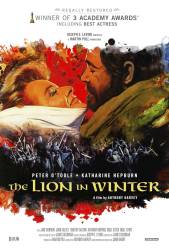Revealing mistake: At the beginning of the movie Geoffrey organises an ambush on a group of infantrymen marching on a pristine beach. When the second group of horsemen attacks there are already tracks in the sand, obviously from previous takes. (00:08:55)
Revealing mistake: When Eleanor comes across the Thames there is no other boat around, however, in a shot from the side you see the bow wave of the boat with the camera crew. (00:17:15)
Continuity mistake: When Eleanor talks to herself in the mirror before Geoffrey enters, the Katherine-Hepburn wave in her hair is different when her reflection is shown. (00:59:45)
Other mistake: The German subtitles translate Brittany as Britannien (Britain), not as Bretagne. (01:04:00)
Factual error: Eleanor uses a paisley-shaped mirror. The paisley pattern comes from India and is designed after the mango, therefore unknown in the England of 1138, centuries before the British set foot on the subcontinent. (01:04:40)
Continuity mistake: When Eleanor comes to free Henry's sons from the dungeon, the officer who is accompanying her stabs the guard in the throat. When he pulls the dagger out there's blood only on one side and nothing on the straw when the guard is kicked across the floor. (01:53:20)
Continuity mistake: In the last scene of the movie Eleanor leaves by boat to go back to her castle prison. When we see Henry waving good-bye he is standing right next to a post when we see him from the back, but this post is nowhere when he is shown from the water. (02:08:10)
Factual error: Eleanor makes a reference to syphilis which was unknown at that time. The disease either originated in the New World and was carried to Europe after Columbus' voyages, or was already in Europe but under a different name. The name "syphilis" was not developed until 1530.
Factual error: After locking his sons in the wine cellar, Henry remarks "The royal boys are aging with the royal port". But "port" refers to a specific type of fortified wine that was not made until about 1670, and it was not given the name "port" until the end of the 17th century.





